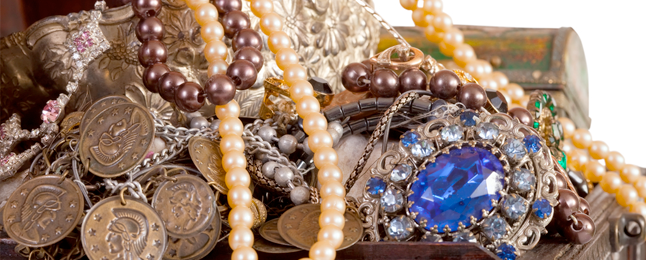Antique Jewellery

An antique in jewellery terms is described as being over 100 years old. Pieces of jewellery younger than this are classified as vintage, collectable or modern. Pricing of antiques is a specialist area, and there is no substitute for knowledge and experience. It requires a practised eye, and knowledge of manufacturing techniques, as well as an understanding of important fashion periods to recognise a true antique from a copy.
It is much more difficult to ascertain the value of these pieces following loss or theft. It is understood that these items can often be the most ‘valuable’ in a claimant’s jewellery box, in that they represent pieces passed through the family, and often belonged to a family member no longer alive.
Unfortunately, it is a common occurrence that the pieces were kept ‘safe’ and not worn, and so descriptions can very often be a little vague, which combined with the perception that ‘antique’ means ‘expensive’, the validation of antiques can be one of the most challenging tasks we conduct.
It is not always easy to determine that a piece is indeed ‘antique’, ‘vintage’ or ‘collectable’. Many pieces of jewellery have been assayed, i.e. the item has been stamped with date, regional and maker’s marks, however, many haven’t. Assay is a process that in England and some parts of Europe has been in practice since the 17th century and provides an independent assessment of the metal used and the date of manufacture.
For many other countries, including Australia, this system of Assay has not been used and so it is difficult to accurately date these pieces other perhaps than by the style, technique of manufacture or materials used.
There are also some other misconceptions which we often encounter:-
The ring was over 50 years old - it has to be an antique
No, it needs to be over 100 years old.It was over 50 years old, so the stones couldn’t be synthetic
Synthetic Rubies were developed in the early 20th century, and coloured glasses were used for many centuries prior to that.-
My antique bangle has a few dents in it, but that won’t affect its price. It is an antique after all!
Unfortunately, it will. Although the piece may be old, it still needs to be in an attractive and wearable condition to pick up any premium for its age. We do however consider whether it is easily repairable without damaging the authenticity of the piece. It was gold, and had white stones and was old – they must be diamonds!
Before Cubic Zirconias, other white stones were used as a cost effective alternative, including white Sapphires, Spinels, and Quartz.I have an antique pocket watch, it doesn’t work but it must have a value for its age.
Yes, it probably does, and there is indeed a thriving market for old pocket watches and some retro wristwatches even though they may not be in working order. However when they are appraised, it is at market value LESS the cost of repair. Remember many of these pocket watches had hand made parts so repairs can often rise into several hundred dollars.My Pearls are over 50 yrs old ,they have to be real ones.
Not necessarily as imitation Pearls have been available for many years. During the 1920’s Pearls were hugely popular in sometimes ridiculously long lengths, and numbers of strands, so many less expensive shell based products were produced.I have a reproduction piece, it still cost a lot of money, and has a hallmark!
Reproduction pieces are just modern copies of antique styles. They are often made of gold and gemstones and their cost reflects that. The hallmark however should reflect the date of manufacture, it is illegal to reproduce an old hallmark.
If you do have pieces of jewellery, which you believe to be antique or vintage, try to have them photographed, or better still valued. Then you are aware of the actual value of the piece and can secure them accordingly.
Generally, Insurance replacement is ‘new for old’. In the case of antiques, there is no form of replicating the age of a piece, even though the technique may be copied. It is then accepted that in the event of jewellery loss, validations are provided against a similar antique item where possible. Although the piece will never be identical, appreciators of antique jewellery would often prefer to own an antique or vintage piece, rather than something new. Where an item has been inherited and all sentimental value therefore gone, it is at the client’s discretion as to whether they elect to replace it with a modern or antique piece.


